Sound on the table and with you: a review of the Creative T30 Wireless and Airwave HD
Good day, Habr! I have two new things for you: one allows you to take music with you, the second is a good solution for universal connection of smartphones, laptops, PCs and any other audio source in a compact package. Creative Airwave HD and Creative T30 Wireless on Habré have not yet been, and the network is not much written about them, so who cares - I ask under the cat;)
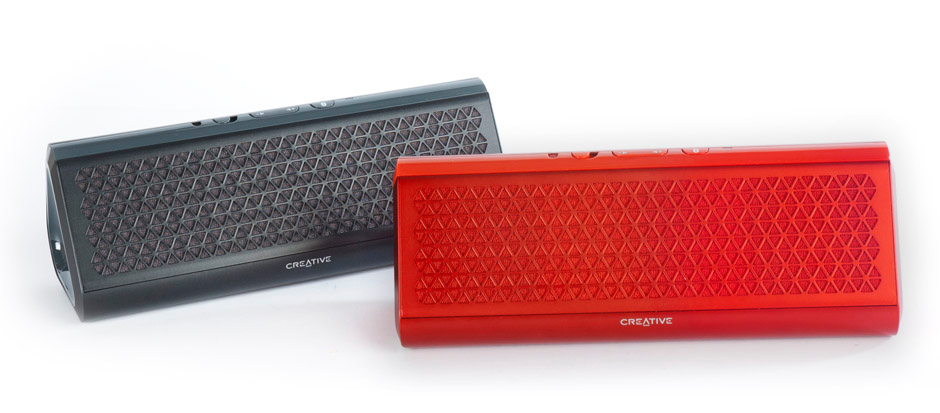

Let's start with a portable solution. I had an older version, Airwave HD, which is built on a simple but effective recipe: a portable “column” with Bluetooth support (with A2DP, of course, for listening to music), NFC (for seamless connection in “one click”) and the ability to use it just like ordinary wired acoustics.
“Triangular” themes prevail in appearance, both in the profile of the column itself and in the decoration / protection of the front surface. The control buttons - nothing at all, a sliding "latch" on / off, a volume control swing and an additional button with a Bluetooth icon. Almost like modern smartphones. :) All controls are mechanical, no sensory stuff, pressed with a well-felt tactile feedback, “on / off” has enough resistance so that the column does not turn on itself in a backpack / bag when carried.
')
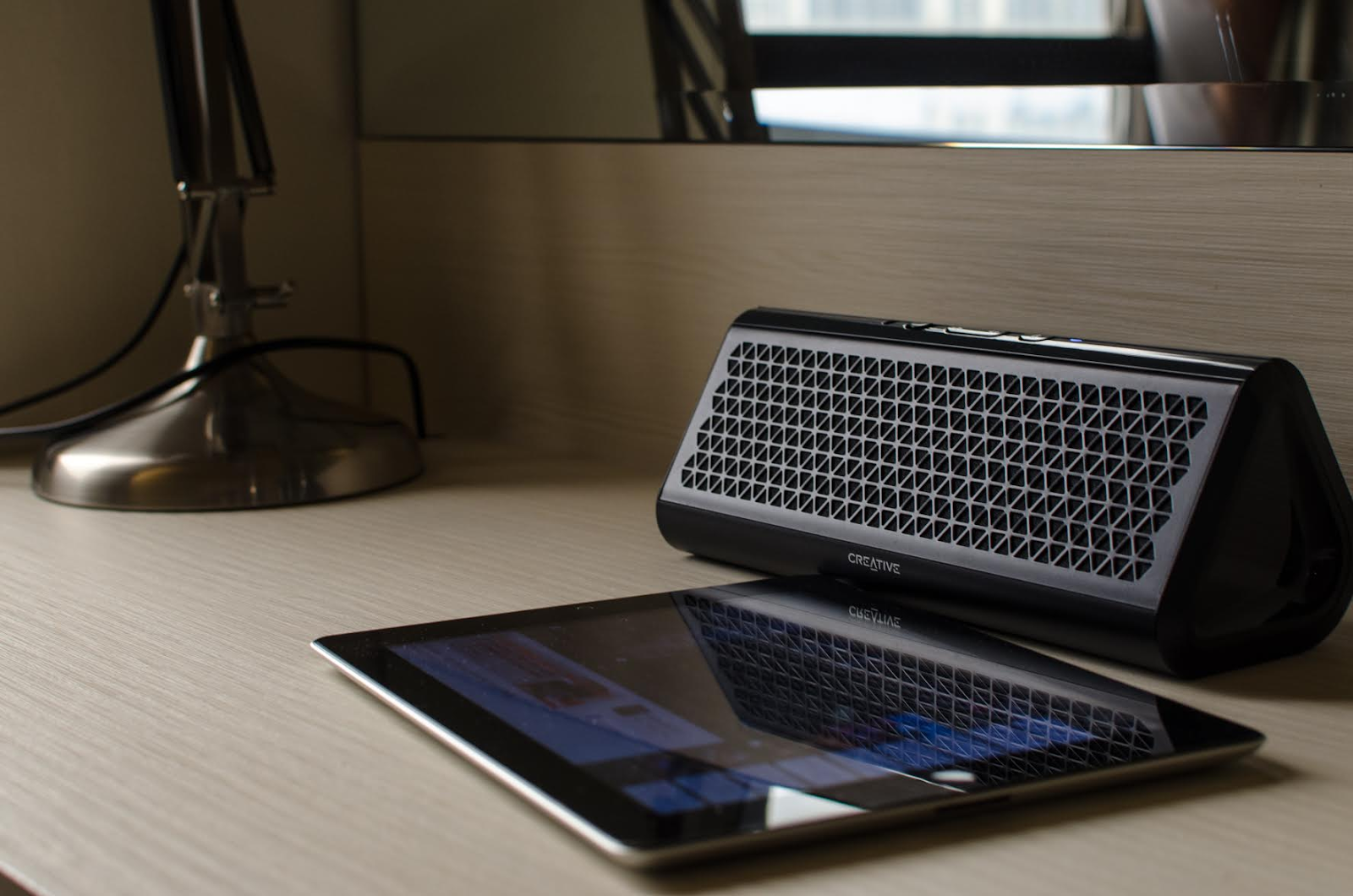
On the "back" (if you can call it that) the panel is a phase inverter, a microUSB input (for the charger) and a 3.5mm MiniJack for a "classic" connection. The active NFC tag is also located on the back panel: when the smartphone is first presented, it will offer to contact via Blueetoth (turn it on if it is off, make a bundle of devices), for the second and subsequent ones, just turn on BT, connect to the speaker and start playback. It's hard to overestimate the capabilities of NFC, yet “brought up, clicked yes, it works” - much nicer than “I turned on the bluetooth, I found in the instructions how to connect a speaker and an iPhone, hold the Bluetooth button, and so on.” So while the Yabloko are messing around with the connection, we can appreciate the sound itself.

To transfer sound through the text - that is still a little problem. Column ... moderately loud, from a distance of ~ one meter, I measured about 80-90 dB through a mobile application on my smartphone. (Maximum volume, playing music of various genres). On any works from Airwave HD there is a fairly clear sound (as pure as the musical work itself and the quality of the recording implies), the speaker does not choke on the bottoms, very soundly digests the high sounds. Up to 20 kHz at least. In general, the sound can be described as “decent”: any laptop, be it a MacBook Pro 15 or Asus with Bang & Olufsen sound and a mini-subwoofer, plays the speaker both in sound quality and in volume. The quality of the result is comparable to the speakers for a PC for 1000-1500 rubles: in terms of volume, I think it will be a little inferior, but there the usual speakers will wheeze, but here you just have a reasonable limiter.
According to the manufacturer, Airwave HD has a 10W output power and is capable of working up to seven parts without interruption. As for Watts, I can’t say for sure, measurement of the output power on the dynamics is still a circus, starting with at least three possible methods of various tests known to me (determining sinusoidal power according to DIN, according to RMS, and bloated “Chinese” PMPO-Watts) ending with the banal complexity of their conduct at home. But the time of the autonomous service can be checked and it is very easy to measure, record, charge, repeat. In the first case, I got about 6 hours of work, in the second, third and so on - from 6 and a half to 7 and a half hours, if the indicators are averaged - something like this will be: seven hours at medium volume with Bluetooth playback.
By the way, since the speaker is connected via BT, then why not use it as a portable microphone? Apparently, I did not think so alone, so Creative Airwave HD can be safely used for Skype conferences or as a “speakerphone” - it has an excellent sensitive microphone, and when connected to a Bluetooth connection, the speaker is defined as a “headset”, so that with the use of this functionality does not exactly occur.
In the field of mobile sound competition is quite dense. On the one hand, there are companies that have “grown up” on mobile phones (like Jawbone), on the other hand, there are classic “soundtracks” and large companies that are trying to descend into this segment to make it happen. Similar to the characteristics of Airwave HD mobile audio systems - JBL Charge and Jawbone Mini Jambox / Jambox, and, probably, Beats Pill.

The characteristics are about the same for everyone: there is nothing surprising, the laws of physics cannot be fooled, you can’t force a small squeaker to give out juicy basses, and I haven’t seen 40-inch tweeters.
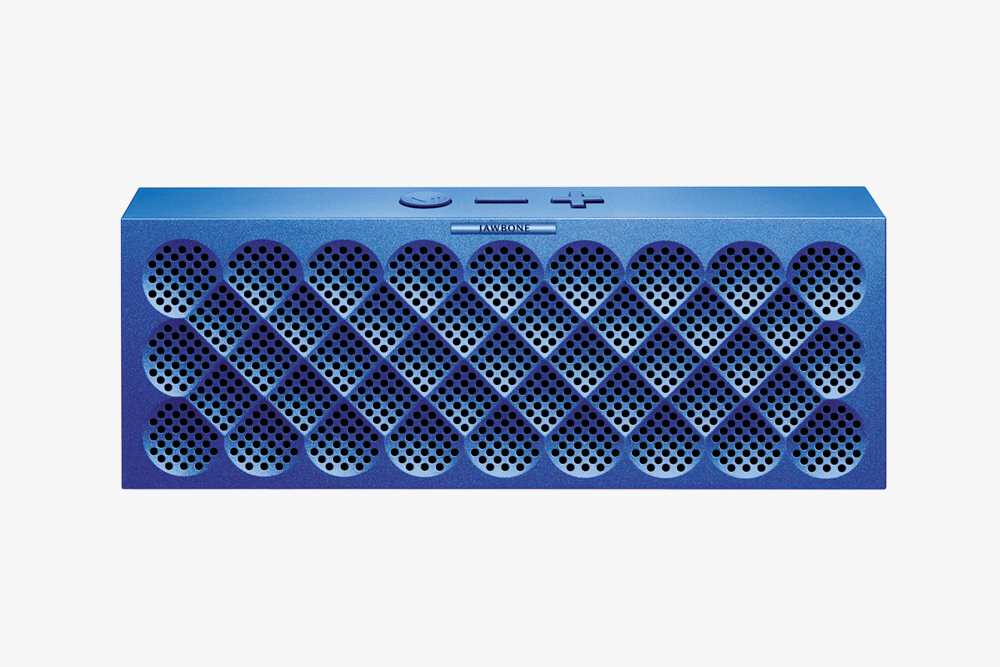
Differences - in batteries, the presence / absence of NFC and the ability to charge the device from the music docking station. The latter is at JBL Charge (this is even in the name rendered), and NFC is present in Beats Pill; Jawbone, apparently, are focused on the apple, who have no NFC :)
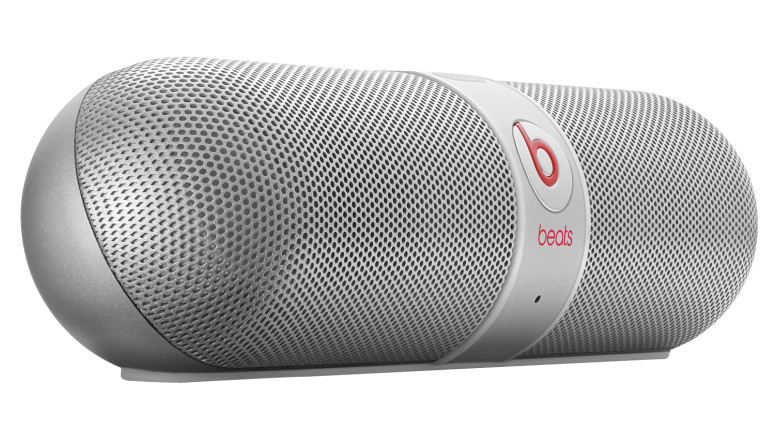
But the price / exhaust ratio strongly depends on the region, but almost all solutions from competitors in this class will be more expensive than Airwave HD, and with the cheaper ones you can compare the younger version of the rim - Creative Airwave. The average prices in the Yandex market in the middle of May are around 4,200 rubles for the older model and 2,000 for the younger one. Not so much for the opportunity to take music with you - to work, to a picnic, or simply for a convenient multifunctional speaker, which you can pick up to both the laptop and the smartphone.

The second hero of the review is the Creative Wireless T30 desktop system. Neat and small speakers with an indecent, at first glance, price of ~ 6,000 rubles. What kind of money? First, it is not just desktop “tweeters”, but a full-fledged sound system: each column has two diffusers, for high and medium frequencies, a huge phase inverter and, apparently, some demon inside is locked in a cage: for its size at T30 Wireless indecent-deep, rich and clear sound. Secondly, the system is not so easy to have a postscript "Wireless", NFC tag + Bluetooth channel allow you to connect a smartphone or laptop to the speakers.
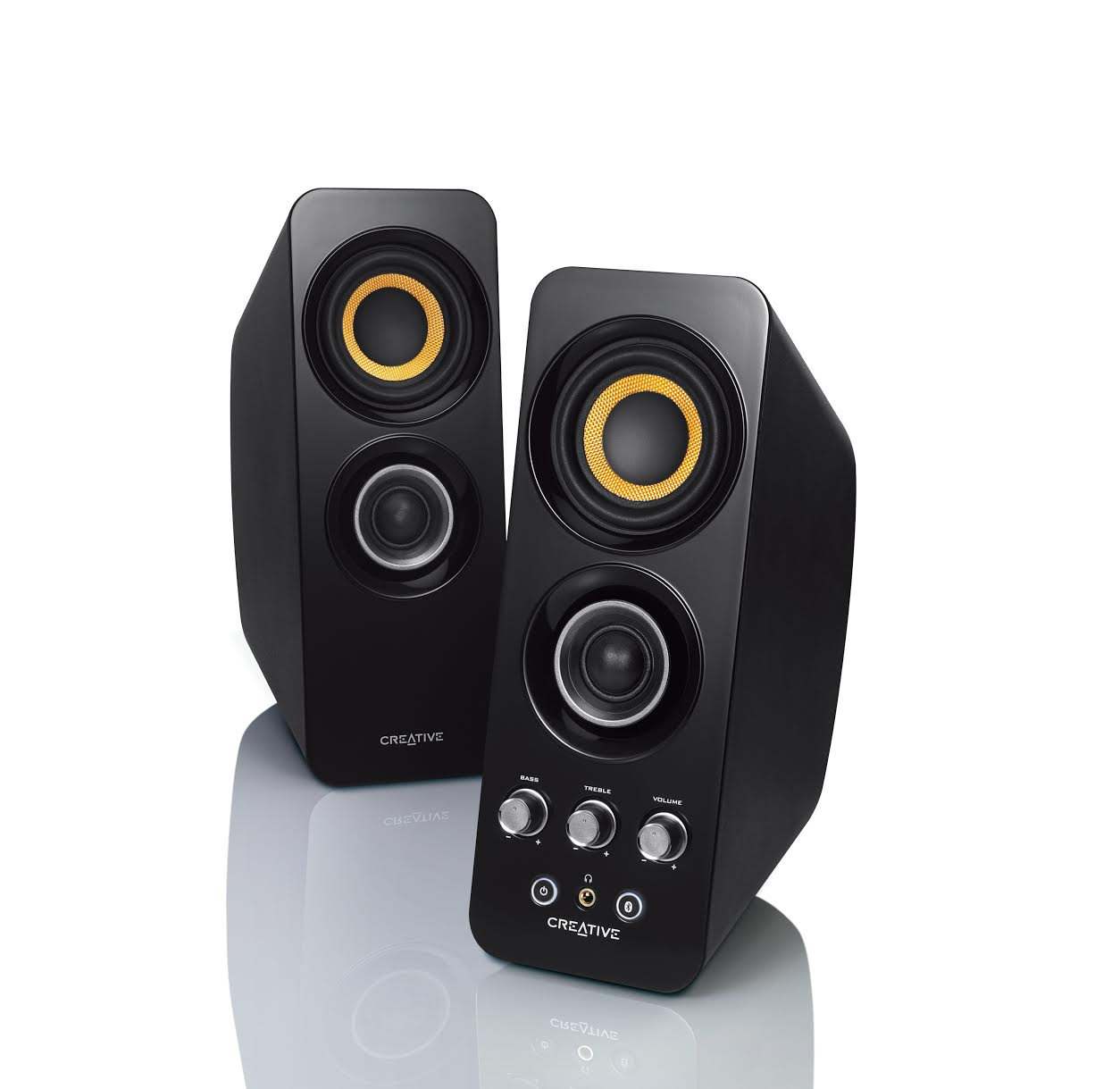
Designer - at the same time and solid five, and not. Why? Easy to explain: the speakers look great, easy to control, everything is in place, the case is pleasing to the eye and the materials are tactile very, very pleasant, but ... the front and back panels are made of glossy plastic.
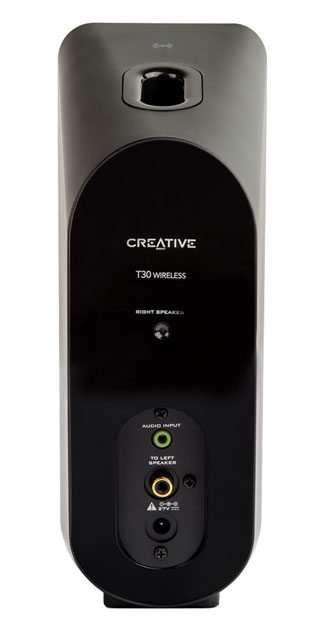
Yes, it's more beautiful, and on the renders it looks more expensive, and in reality it adds some gloss to the look, but ... it is not a varnished wood. This is plastic. He collects prints and dust, and remove them (especially from the column on which all the controls are located) is another task. A black aluminum panel with a coarse polished texture would not look cheaper, but it would save the T30 from the constant need to wipe with microfiber.
All controls (three knobs: volume, woofer, and treble; yes, two buttons: power and Bluetooth) are on the right speaker, and all wires also fit (power, second satellite, Aux-in). In principle, the instructions for the T30 can not be opened - all have long been accustomed to, that the pairing-mode is caused by long holding the Bluetooth button, and the inscription NFC on the top unambiguously hints where to put the phone so that everything works automatically. The label is exactly the same as in Airwave or other Creative products (headphones, speakers), the smartphone turns on Bluetooth itself, finds the speakers, adds them to the device list and connects. When reused, it simply turns on the necessary wireless interfaces and automatically connects to the audio system. It's simple.
As I said at the beginning of the section: the sound is indecently good for such a compact acoustics: the high frequencies are very precisely and vividly worked out, the sound is mild and without a “plane” in the medium with medium, well, and for a system without an active sub woofer, many deep low frequencies . How this was achieved by Creative engineers is a mystery. Perhaps part of the merit lies on high-quality e-stuffing and software processing, part on the impressive size of the phase inverter located on the upper edge of each of the columns, and maybe the creators really used some black magic: unfortunately, they do not reveal all the secrets, but on the official The site states the following: for tweeters, silk fiber diffusers were developed, midrange speakers were made of conical fiberglass diffusers (although, admit, the appearance looks more like aramid fibers, but without chemical expert I can’t guarantee anything, but I don’t want to spoil the speakers), and the system with the vertical phase inverter was called BassXPort , but I don’t think that the proprietary names add any color to the sound.

On a test track listing consisting of a mix of jazz, classical, rock and classical metal, the columns were surprised every 5-6 minutes. The sound is detailed, the separation of high and mid frequencies is felt into two different circuits, the system does not wheeze even at maximum volume (although, I confess, a slight lack of low frequency begins to be felt at the maximum, but this is the ultimate mode of operation, so I see no reason to consider it as a normal state) , on the whole ipodazone from ¼ to ¾ of the volume reserve, there is an excellent balance between the quality and the development of all three main ranges. We are also pleased with the built-in tweeter / bass control: you can always adjust the sound to the “habitual” for your ear ratio of sonorous tops and rich MF / LF.
In wireless mode, the aptX codec is responsible for transmitting audio: if your smartphone supports this technology, then the quality of the sound sent over the wireless channel will be at its best. It is almost impossible to distinguish from a wired connection in a blind test (rather, it is impossible at all), especially if you listen to unofficial compositions. But if you prepare specially, then, of course, you can pick up a couple of tracks that will sound a little different, and give you Bluetooth connections, but who needs such perversions? The sound is clear, the delays are minimal or out of place (in general, delays are detected very easily: you start demanding races on your smartphone, plug in wireless speakers / headphones and at the moment of receiving any bonuses, collisions or any other effects, “dissynchronous” will instantly show up). What else is needed? Is that the NFC in the iPhone, so that the adherents of the apple it was easier to connect.
Excellent sound, work on wires and without wires, Creative's proprietary ability to connect directly to two sources or to two pairs of speakers using a wireless protocol, a pleasant appearance and an impractical front panel. If your main workhorse is a laptop, or you have a small room, and you prefer to keep music on your phone, and choose new speakers, this is an interesting candidate for purchase. The combination of price, quality and functionality is excellent, and competitors in the niche are not particularly observed. Of course, for this money you can buy an honest 5.1 system or powerful 2.0 speakers like Microlab Solo3 / Solo4, but you don’t always need a similar overkill, and even connecting such systems to laptops / smartphones sometimes causes quite definite problems: you need an external zvukovuha, either amplifier; About the wireless functionality, and in general you can forget. In general, you decide, of course, but if you need good desktop speakers and you don’t mind using the wireless functionality, the T30 is waiting for you.


Let's start with a portable solution. I had an older version, Airwave HD, which is built on a simple but effective recipe: a portable “column” with Bluetooth support (with A2DP, of course, for listening to music), NFC (for seamless connection in “one click”) and the ability to use it just like ordinary wired acoustics.
Color and format
“Triangular” themes prevail in appearance, both in the profile of the column itself and in the decoration / protection of the front surface. The control buttons - nothing at all, a sliding "latch" on / off, a volume control swing and an additional button with a Bluetooth icon. Almost like modern smartphones. :) All controls are mechanical, no sensory stuff, pressed with a well-felt tactile feedback, “on / off” has enough resistance so that the column does not turn on itself in a backpack / bag when carried.
')

On the "back" (if you can call it that) the panel is a phase inverter, a microUSB input (for the charger) and a 3.5mm MiniJack for a "classic" connection. The active NFC tag is also located on the back panel: when the smartphone is first presented, it will offer to contact via Blueetoth (turn it on if it is off, make a bundle of devices), for the second and subsequent ones, just turn on BT, connect to the speaker and start playback. It's hard to overestimate the capabilities of NFC, yet “brought up, clicked yes, it works” - much nicer than “I turned on the bluetooth, I found in the instructions how to connect a speaker and an iPhone, hold the Bluetooth button, and so on.” So while the Yabloko are messing around with the connection, we can appreciate the sound itself.

Sound
To transfer sound through the text - that is still a little problem. Column ... moderately loud, from a distance of ~ one meter, I measured about 80-90 dB through a mobile application on my smartphone. (Maximum volume, playing music of various genres). On any works from Airwave HD there is a fairly clear sound (as pure as the musical work itself and the quality of the recording implies), the speaker does not choke on the bottoms, very soundly digests the high sounds. Up to 20 kHz at least. In general, the sound can be described as “decent”: any laptop, be it a MacBook Pro 15 or Asus with Bang & Olufsen sound and a mini-subwoofer, plays the speaker both in sound quality and in volume. The quality of the result is comparable to the speakers for a PC for 1000-1500 rubles: in terms of volume, I think it will be a little inferior, but there the usual speakers will wheeze, but here you just have a reasonable limiter.
Autonomy and Watts
According to the manufacturer, Airwave HD has a 10W output power and is capable of working up to seven parts without interruption. As for Watts, I can’t say for sure, measurement of the output power on the dynamics is still a circus, starting with at least three possible methods of various tests known to me (determining sinusoidal power according to DIN, according to RMS, and bloated “Chinese” PMPO-Watts) ending with the banal complexity of their conduct at home. But the time of the autonomous service can be checked and it is very easy to measure, record, charge, repeat. In the first case, I got about 6 hours of work, in the second, third and so on - from 6 and a half to 7 and a half hours, if the indicators are averaged - something like this will be: seven hours at medium volume with Bluetooth playback.
Bluetooth
By the way, since the speaker is connected via BT, then why not use it as a portable microphone? Apparently, I did not think so alone, so Creative Airwave HD can be safely used for Skype conferences or as a “speakerphone” - it has an excellent sensitive microphone, and when connected to a Bluetooth connection, the speaker is defined as a “headset”, so that with the use of this functionality does not exactly occur.
Competitors
In the field of mobile sound competition is quite dense. On the one hand, there are companies that have “grown up” on mobile phones (like Jawbone), on the other hand, there are classic “soundtracks” and large companies that are trying to descend into this segment to make it happen. Similar to the characteristics of Airwave HD mobile audio systems - JBL Charge and Jawbone Mini Jambox / Jambox, and, probably, Beats Pill.

The characteristics are about the same for everyone: there is nothing surprising, the laws of physics cannot be fooled, you can’t force a small squeaker to give out juicy basses, and I haven’t seen 40-inch tweeters.

Differences - in batteries, the presence / absence of NFC and the ability to charge the device from the music docking station. The latter is at JBL Charge (this is even in the name rendered), and NFC is present in Beats Pill; Jawbone, apparently, are focused on the apple, who have no NFC :)

But the price / exhaust ratio strongly depends on the region, but almost all solutions from competitors in this class will be more expensive than Airwave HD, and with the cheaper ones you can compare the younger version of the rim - Creative Airwave. The average prices in the Yandex market in the middle of May are around 4,200 rubles for the older model and 2,000 for the younger one. Not so much for the opportunity to take music with you - to work, to a picnic, or simply for a convenient multifunctional speaker, which you can pick up to both the laptop and the smartphone.

The second hero of the review is the Creative Wireless T30 desktop system. Neat and small speakers with an indecent, at first glance, price of ~ 6,000 rubles. What kind of money? First, it is not just desktop “tweeters”, but a full-fledged sound system: each column has two diffusers, for high and medium frequencies, a huge phase inverter and, apparently, some demon inside is locked in a cage: for its size at T30 Wireless indecent-deep, rich and clear sound. Secondly, the system is not so easy to have a postscript "Wireless", NFC tag + Bluetooth channel allow you to connect a smartphone or laptop to the speakers.

Appearance and controls
Designer - at the same time and solid five, and not. Why? Easy to explain: the speakers look great, easy to control, everything is in place, the case is pleasing to the eye and the materials are tactile very, very pleasant, but ... the front and back panels are made of glossy plastic.

Yes, it's more beautiful, and on the renders it looks more expensive, and in reality it adds some gloss to the look, but ... it is not a varnished wood. This is plastic. He collects prints and dust, and remove them (especially from the column on which all the controls are located) is another task. A black aluminum panel with a coarse polished texture would not look cheaper, but it would save the T30 from the constant need to wipe with microfiber.
All controls (three knobs: volume, woofer, and treble; yes, two buttons: power and Bluetooth) are on the right speaker, and all wires also fit (power, second satellite, Aux-in). In principle, the instructions for the T30 can not be opened - all have long been accustomed to, that the pairing-mode is caused by long holding the Bluetooth button, and the inscription NFC on the top unambiguously hints where to put the phone so that everything works automatically. The label is exactly the same as in Airwave or other Creative products (headphones, speakers), the smartphone turns on Bluetooth itself, finds the speakers, adds them to the device list and connects. When reused, it simply turns on the necessary wireless interfaces and automatically connects to the audio system. It's simple.
Sound
As I said at the beginning of the section: the sound is indecently good for such a compact acoustics: the high frequencies are very precisely and vividly worked out, the sound is mild and without a “plane” in the medium with medium, well, and for a system without an active sub woofer, many deep low frequencies . How this was achieved by Creative engineers is a mystery. Perhaps part of the merit lies on high-quality e-stuffing and software processing, part on the impressive size of the phase inverter located on the upper edge of each of the columns, and maybe the creators really used some black magic: unfortunately, they do not reveal all the secrets, but on the official The site states the following: for tweeters, silk fiber diffusers were developed, midrange speakers were made of conical fiberglass diffusers (although, admit, the appearance looks more like aramid fibers, but without chemical expert I can’t guarantee anything, but I don’t want to spoil the speakers), and the system with the vertical phase inverter was called BassXPort , but I don’t think that the proprietary names add any color to the sound.

On a test track listing consisting of a mix of jazz, classical, rock and classical metal, the columns were surprised every 5-6 minutes. The sound is detailed, the separation of high and mid frequencies is felt into two different circuits, the system does not wheeze even at maximum volume (although, I confess, a slight lack of low frequency begins to be felt at the maximum, but this is the ultimate mode of operation, so I see no reason to consider it as a normal state) , on the whole ipodazone from ¼ to ¾ of the volume reserve, there is an excellent balance between the quality and the development of all three main ranges. We are also pleased with the built-in tweeter / bass control: you can always adjust the sound to the “habitual” for your ear ratio of sonorous tops and rich MF / LF.
Without wires
In wireless mode, the aptX codec is responsible for transmitting audio: if your smartphone supports this technology, then the quality of the sound sent over the wireless channel will be at its best. It is almost impossible to distinguish from a wired connection in a blind test (rather, it is impossible at all), especially if you listen to unofficial compositions. But if you prepare specially, then, of course, you can pick up a couple of tracks that will sound a little different, and give you Bluetooth connections, but who needs such perversions? The sound is clear, the delays are minimal or out of place (in general, delays are detected very easily: you start demanding races on your smartphone, plug in wireless speakers / headphones and at the moment of receiving any bonuses, collisions or any other effects, “dissynchronous” will instantly show up). What else is needed? Is that the NFC in the iPhone, so that the adherents of the apple it was easier to connect.
In total
Excellent sound, work on wires and without wires, Creative's proprietary ability to connect directly to two sources or to two pairs of speakers using a wireless protocol, a pleasant appearance and an impractical front panel. If your main workhorse is a laptop, or you have a small room, and you prefer to keep music on your phone, and choose new speakers, this is an interesting candidate for purchase. The combination of price, quality and functionality is excellent, and competitors in the niche are not particularly observed. Of course, for this money you can buy an honest 5.1 system or powerful 2.0 speakers like Microlab Solo3 / Solo4, but you don’t always need a similar overkill, and even connecting such systems to laptops / smartphones sometimes causes quite definite problems: you need an external zvukovuha, either amplifier; About the wireless functionality, and in general you can forget. In general, you decide, of course, but if you need good desktop speakers and you don’t mind using the wireless functionality, the T30 is waiting for you.
Source: https://habr.com/ru/post/229141/
All Articles